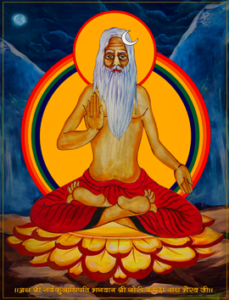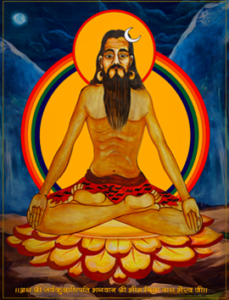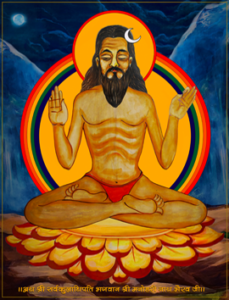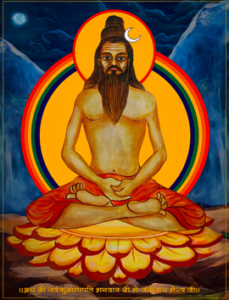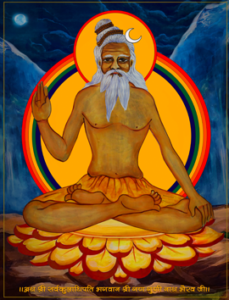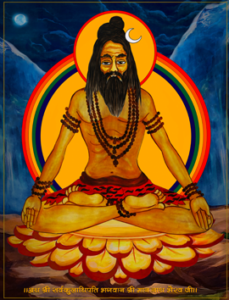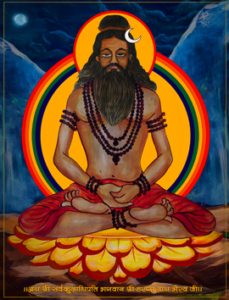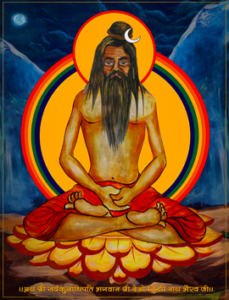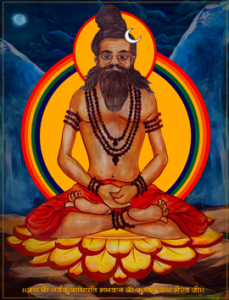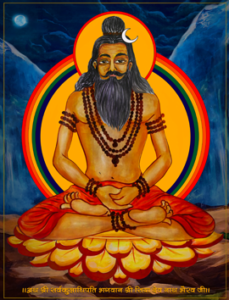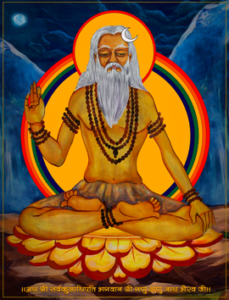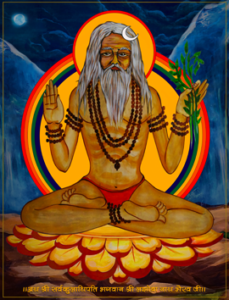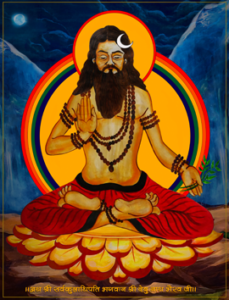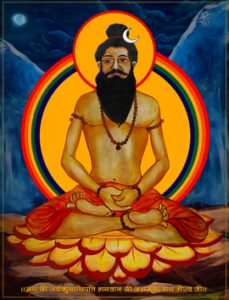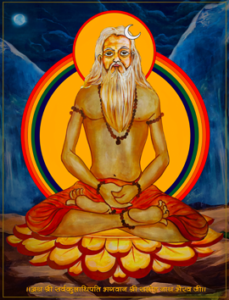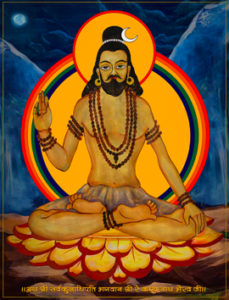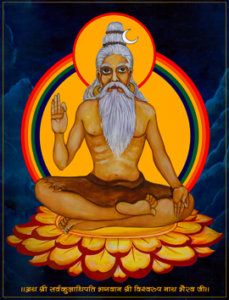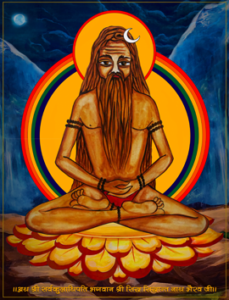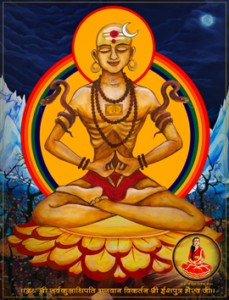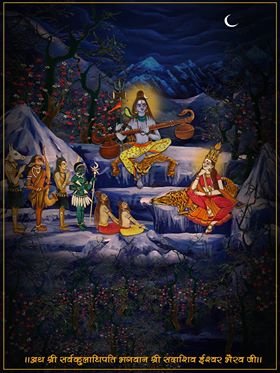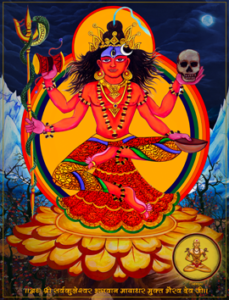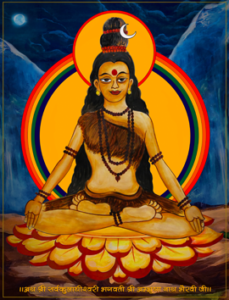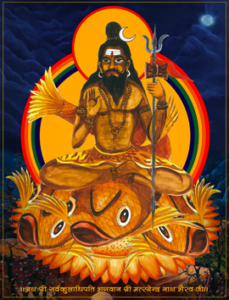Kaulantak Nath, etymologically is the amalgamation of two words Kaulantak (कौलान्तक) and Nath (नाथ). Kaulantak denotes “Kaulantak Peeth” and Nath literally means “Lord” or “Master”. So, the synthesis of the words gives the meaning that “Kaulantak Nath is a Siddha who is the lord and master of Kaulantak Peeth”. The current Kaulantak Nath is His Holiness Mahasiddha Kaulantak Peethadhishwara Mahayogi Satyendra Nath Ji Maharaja (Ishaputra).
The Kaulantak Peeth tradition or Kaula Siddha Dharma believes that Kaulantak Nath is directly related to Lord Shiva personally. It is believed that Lord Shiva himself initiated the Kaulantak Peeth tradition and he himself became the first Peethadhishwara and in doing so, he created the opportunity for future Siddhas to become Kaulantak Peethadhishwara to continue the tradition of Guru/Sishya parampara such that the knowledge and wisdoms of Lord Shiva reach the society with the help of future Siddhas.
Legends of Kaulantak Nath
Based on the popular legend of the Kaulantak Peeth tradition, it is believed that the demon Tarkasura had received a boon from Lord Brahma that he will only be killed by the son of Lord Shiva. Therefore, Tarkasura had becomes very powerful because Shiva was an ascetic and he most of the time was very deeply engrossed in his Samadhi for a long time period. All the gods were worried that Tarkasura will destroy everything if Shiva did not get married and if he did not beget a son. Therefore, they tried everything to wake Shiva from the state of samadhi. They even set up Kamadeva to wake him up from his samadhi but in vain. Lord Shiva opened his third eye and destroyed Kamadeva to ashes.
The gods then prepared Ma Parvati for penance to please Lord Shiva so that Shiva shall marry her as she was also the reincarnation of Ma Sati, the deceased wife of Lord Shiva. Ma Parvati after a tough penance was able to please Lord Shiva and then she received the boon to marry him. After the marriage, when Lord Shiva and Ma Parvati accompanied by Siddhas, were on their way to Mount Kailasha and while they were resting at different places, Ma Parvati questioned Lord Shiva about all the wisdoms and knowledges related to sacred Tantra, Yoga and various other disciplines.
Lord Shiva then explaining her about all the wisdom forms, answered her that he will create a certain enclosed land in midst of the great Himalaya so as to make it a supreme seat of all wisdoms forms and in the future even the society will be able to receive his teachings. He therefore, created the Peeth and he himself became the first Peethadhishwara and he also opened the possibilities of future Peethadhishwara to propagate his eternal wisdoms. He then decided that in future, numerous Peethadhishwara will govern Kaulantak Peeth to propagate his eternal wisdom.
Later, Lord Kartikeya was born and he killed the demon Tarkasura, thus fulfilling the boon made to Tarkasura.
Kaulantak Nath tradition post Lord Shiva
Based on the legends of Kaula Siddha tradition, Kaulantak Nath is a spiritual seat that can never be empty. It has to always be occupied by Siddhas. It can never be left empty or unattended because it needs a Siddha to impart the wisdom forms of the eternal Lord Shiva to the society. So, based on this very notion, Ma Parvati while walking towards Mount Kailasha, asked him what will the post of Kaulantak Nath be after they reach to Kailash? The Lord then replied her that the post could never be left empty and unattended so the duty will be delegated to her to appoint worthy Kaulantak Naths in future to preserve the tradition. It was because of the duty ascribed to Ma Parvati, the Peeth which basically was a Shaiva Peeth got infused with Shakta tradition and now they are very much inseparable.
Ma Parvati then continued the tradition of Kaulantak Nath by assigning the Sapta Rishis as the Kaulantak Naths. These seven Rishis were Maharishi Atri, Maharishi Bharadwaja, Maharishi Gautama, Maharishi Jamadagni, Maharishi Kashyapa, Maharishi Vashista and Maharishi Vishwamitra. But Sapta Rishis too were deeply engrossed in their sadhana so the constant need of Kaulantak Naths was eminent. In that very period, the Kaulantak Peeth also witnessed its first female Kaulantak Nath. She is also known by the name Maharishika Ambhrisha (Ambhrishika).
Ma Parvati divided herself into three forms, basically representing the three modes of nature, the Satwa, Rajas and Tamas. The satwa mode transformed to Sukulla form, Rajas mode to Kurukulla and Tamas form to Vikulla. Similarly, Lord Shiva also divided himself based on the same as Shakti to Swatantra Bhairav for the Sukulla, Mukta Bhairava to Kurukulla and Vikral Bhairava to Vikulla.
Goddess Sukula then settled at the hidden mountain ranges between Kashmir and modern day Uzbekistan. Her tradition was later renamed as Kashmiri Saivism. Goddess Kurukulla settled at the hidden mountain ranges between the Uttarakhand and Kashmir, Nepal and upper Tibet. It is also believed that the place Kullu derived its name from the word “Kulluta” and Kulluta derived its name from the goddess Kurukulla herself. Her form Vikula, settled at the mountain ranges that lies somewhere between Nepal, Bhutan extended to some places of Myanmar. The place is also known as “Kaamaru Desh” which can extensively be found in the text of “Kaula Jyana Nirnaya” by Mahasiddha Matsyendra Nath Ji Maharaja. The “Kaamaru Desh” as based on Kaula Siddha tradition started from the land of Vikulla and extended till the ends of South East Asia encompassing places like Thailand, Bali, Cambodia etc
After the partition, the three goddesses further divided themselves into thousands of Yoginis and Lord Shiva divided himself to thousands of Bhairavas and ultimately leading to many lineages. The Yoginis and Bhairavas from different parts of the world also migrated to the Himalaya. The list of the Bhairavas and Yoginis were basically among the given types.
– Nagas (The serpant like Gods)
– Sarpas (The crawlings Gods)
-Ashwas (The horse rider Gods)
-Vayumukhis (The Gods travelling in the speed of wind)
– Vrikshasthitas (The Gods residing in the trees)
-Nirjharshitas (The Gods residing at the waterfalls, fountains etc)
-Falasthitas (The Gods residing in the fruits)
-Kamandalusthitas (The Gods residing in the stoup)
-Dandasthitas (The Gods residing in the sticks and logs)
-Pushpasthitas (The Gods residing inside the flowers)
-Dhatusthitas (The gods residing in the metal elements)
-Bhusthitas (The Gods residing in the land and in the soil)
-Ratrichari (The nocturnal Gods)
-Vanachari (The forest dwelling Gods)
-Vyomchari (The sky dwelling Gods)
-Bahurupi (The Gods who could change forms)
-Samyukta (Many Gods attached to the same body)
-Adrishya (The invisible Gods)
-Guptagana (The Gods who remains hidden)
-Rishirupi (The hermits like Gods)
-Ratnasthitas (Gods residing in the jewels)
-Sagarsthitas (Gods residing in the oceans and seas)
-Nilkhandi (Gods who migrated from the traditional Panch Peeth to the Himalayas)
The aforementioned Gods and Goddesses, who were thus formed, asked the permission of Goddess Kurukulla to reside in the areas of Himalayas near to her proximity. She then granted them the boon that they could reside in the areas of the Himalayas with other gods and goddesses until the mid Kali yuga.
From every Yoginis and Bhairavas as mentioned above, a new lineage started to emerge and it was decided by Gurumandala and various Siddhas that through the competition held between various lineages, a Kaulantak Nath will be chosen. Our lineage, Kaula Siddha Dharma is based on the tradition of Yogini Siddhas and we have also produced many Kaulantak Nath that have provided extraordinary service to the welfare of the world.
The modern day belief of the Kaulantak Nath tradition is that Ma Parvati with the purpose of giving Kaulantak Nath its successive successors created Adi 84 Siddhas who would all eventually occupy the seat of Kaulantak Nath. The Adi 84 Siddhas or the perfected beings all took the seat of Kaulantak Nath. The tradition continued until Maha Matsyendra Nath. He then created the mandala of Nava 84 Siddhas of the modern day. They all occupied the Kaulantak Nath position and the trend continued till Mahasiddha Siddha Siddhanta Nath Ji Maharaja and ultimately to His Holiness Mahayogi Kaulantak Peethadhishwara Mahayogi Satyendra Nath Ji Maharaj (Ishaputra) who is also the current Kaulantak Nath.
After the creation of Nava 84 Siddha mandala by Mahasiddha Matsyendra Nath, he regrouped them all and gave them the liberty to preach Kaulantak Peeth as per their own discretion. It had its own benefit as well as its own downfall. The benefit incurred was that the Siddhas then created their own lineages and lots of people were connected to the Kaulantak Peeth but the downfall was that the original tradition of Kaula Siddha tradition went unrecognized. Since the nava 84 Siddhas were deeply committed to further their own lineages, there came a problem with appointing a new Kaulantak Nath. For instance, Mahasiddha Goraksh Nath was also one of the Kaulantak Nath in that era but he was also busy propagating his “NATH” lineage. Therefore, his Kaulantak Nath stint was for a short period. Then Mahasiddha Matsyendra Nath appointed a new Kaulantak Nath to further the Kaulantak Nath tradition. The new anointed Kaulantak Nath took the tradition to further hibernation because the Peeth was considered to be a very mysterious and secretive Peeth from its inception and also in the name of preserving the very status quo, the Kaulantak Nath tradition went to a long hibernation.
The further Kaulantak Naths went unnoticed due to strict hibernation. Then at the reign of Shree Gori Kandhha Nath Siddha, the rules were changed. He decided that the names of the Kaulantak Nath should be recorded so to preserve the sanctity of the lineage itself. So, he passed a circular among the Siddha tradition to keep the records of the Kaulantak Nath tradition in the form of oral tradition. His disciple Shree Bhim Chila Nath Siddha then started to keep the record and the lineage continued till the modern day to His Holiness Kaulantak Peethadhishwara Mahayogi Satyendra Nath Ji Maharaja (Ishaputra).
The list of Kaulantak Naths from the reign of Shree Gori Kandhha Nath Ji Siddha till the modern day is as given below.
ut the fundamental procedure of selecting Kaulantak Nath totally lies in the hands of Gurumandala. They always strive to find someone who can further the spiritual wisdoms to the new generations. The selection procedure of any Kaulantak Nath starts from the very childhood. The Gurumandala who are Mahasiddhas, they are endowed with certain powers by the virtues of their sadhanas and they use different methods and procedures to spot a child who based on Jyotisha, Samudrik Sastra has the potentiality of becoming Kaulantak Nath. Through the use of their spiritual powers or yogabala, they spot the avataras.
An avatara is someone who has descended down from his/her previous level of consciousness voluntarily to achieve a higher goal then the last birth. Avatara descends with a purpose. The Gurumandala spots the avatara and then looks for signs and symbols. Their first duty is to classify the character traits of the avatara as per satwa, rajas and tamas. Based on the character traits, the Gurumandala then adopts their way of empowering the kid to various spiritual disciplines.
For instance, an avatara with satwik guna is taken from the society amidst secret places and then the empowerment procedures are conducted in a very secretive way. The rajas filled avatara is kept amidst the society and is empowered there and then trained there to adopt with the society. The tamas filled avataras are taken to the cemetery or samshana for empowerment.
The Gurumandala based on their own discretion can appoint gurus of different lineages to empower the avatara to various disciplines. For instance, His Holiness Mahayogi Satyendra Nath Ji Maharaja (Ishaputra) was spotted by his Guru, Mahasiddha Siddha Siddhanta Nath Ji Maharaja through his divine powers. He then looked for the sign and symbols on the body and body languages of Ishaputra. He then informed the parents of Ishaputra and then the parents agreed to his initiation.
Ishaputra was then initiated into the lineage of Kaula Siddha. After the initiation, he was empowered into many spiritual disciplines. He learnt different disciplines through different Gurus. The Gurumandala assigned 38 divine Gurus for his empowerment. He received the empowerment of Aghora from his Guruma who hailed from Kamarupa side to the empowerment of Mrikula through Bhairavi Mrigakshi etc. He also received various teachings from Gurus of different lineages and Ishaputra also learnt it with great enthusiasm. At the age of 21, he became the youngest Kaulantak Nath of all time which is a record in itself.
The Gurumandala when choosing the avataras do not put all the eggs in one single basket. They look for different possibilities and they leave no stones unturned to find the perfect Siddha for the post. Furthermore, their selection procedure is not based on nepotism and favoritism. They do not base their selection module on any particular creed, caste, class and tantric lineages. Himalaya harbors more than 250 active tantric Kula and the Gurumandala regards all the Kula lineages the same. They do not favor a particular Kula over the other. For instance, His Holiness Ishaputra was not the only one chosen to be trained for the post of Kaulantak Nath. He along with his 5 god brothers were chosen at different time periods and they were all given the same empowerments and teachings. It was his pure hard work that he mastered all the disciplines given to him by his Guru.
Finally, when the right time of anointing the new Kaulantak Nath comes, the Gurumandala gathers all the potential candidates and then tests them on various disciplines. Based on their constant past evaluations and their tests, the Gurumandala through discussion between them anoint a new Kaulantak Nath. But the final say of any anointment of Kaulantak Nath is rested upon the discretion of Gurumandala and decisions are never debated upon. They usually anoint someone who has the potentiality to lead society to new direction. In short, the selection procedure of Kaulantak Nath ultimately lies in the hands of Gurumandala.
Rights and Duties for Kaulantak Nath
Kaulantak Nath is one of the highest achievements in the field of oriental wisdom. To be a Kaulantak Nath means to transcend all wisdom, to master it and then become Shiva like and then pass the wisdom to the next generation Siddhas. The Kaulantak Nath though is the highest seat of oriental wisdom yet some rules and regulations do apply to Kaulantak Nath. Following are some of the rights and duties of Kaulantak Nath that he is bounded by at all times
Rights
Kaulantak Nath exclusively enjoys some rights endowed to him by the great Gurumandala. Some of the rights are as given below
Right to Privacy
Kaulantak Nath is endowed with right to privacy and also the right to keep things private by both Gurumandala and the Kaula Siddha Dharma. The Kaulantak Nath has to right to keep himself private and not become socially available for everybody. This right is based on the notion that though Kaulantak Nath is obliged to train Bhairava and Bhairavis, it necessarily doesn’t mean that he has no discretion on who and for whom to become socially available. He is only accountable towards his Bhairava and Bhairavis because he was sent to the society with the aim of educating his Bhairava and Bhairavis. Therefore, respecting the obligations, our current Kaulantak Nath Mahayogi Satyendra Nath Ji Maharaja organizes a monthly sadhana camp to become available for his Bhairava and Bhairavi
Right to protect the Kaula Siddha Dharma
Kaulantak Nath is the Guru of all Gurus. He is the head of all Kaulas and other Kulas of the Himalaya. Therefore, it is both his rights and duties to protect the Kaula Siddha Dharma. In exercising his rights, he might present some criticism against any Gods and Goddesses, lineages and traditions but the criticism is to only be interpreted for education and illustrative purpose. Every aspect has both subjective and objective view. The objective view is universal but the subjective view is subjected to lineages, traditions, individuals etc. Therefore, everything presented by him might not be socially preferable by everybody because it is their own subjective view and it is not universal. Therefore, Kaulantak Nath has the right to protect Kaula Siddha Dharma from subjective criticism of the people.
Right to teach Kaula Siddha Dharma as it is
Nothing in this world can ever prevent Kaulantak Nath to teach and propagate Kaula Siddha Dharma. Kaula Siddha Dharma is a Guru/disciple lineage tradition and it only teaches things based on the tradition of the Guru’s. Since, Kaula Siddha Dharma is a very rare and secretive lineage; we believe that there are no other persons in this society who would be able to teach Kaula Siddha Dharma to us with exact precision like Kaulantak Nath. Since, there is non-availability of other Siddhas who can teach us Kaula Siddha Dharma, it is therefore meaningless to stop or prevent Kaulantak Nath to teach Kaula Siddha Dharma or to ask Kaulantak Nath to modify the teaching procedure. Since, he is the last remaining Kaulantak Nath, it will also be meaningless to teach him what Kaula Siddha Dharma should be like.
DUTIES OF KAULANTAK NATH
To train Bhairavas and Bhairavis
It is the prime duty of Kaulantak Nath to grant various dikshas and to empower Bhairava and Bhairavis. The most authentic empowerment is the empowerment by the Kaulantak Nath. Kaulantak Nath is the Guru of all Gurus so being the seat of premier Guru; it is his prime duty to train Bhairava and Bhairavi as per Kaula Siddha tradition. This obligation of Kaulantak Nath to empower and initiate Bhairava and Bhairavi is mandatory and there is no reservation for him to waive this duty. The Kaulantak Nath is bound to not discriminate between his Bhairavas and Bhairavis based on their caste, creed, sex, religion etc. He is only bound to his Bhairavas, Bhairavis and the Siddhas and not to other people who have no spiritual and lineage affinity. For instance, a government teacher’s duty is to only teach those students who are enrolled in that government school. Just because it is government run school doesn’t mean that any person can enter into the class and learn from the teacher. Similar is with Kaulantak Nath, he is not obliged to teach every seekers of spiritualism but only his Bhairava and Bhairavis.
As far as punishment is considered, just like the government teacher though is obliged to teach his/her student, he also enjoys exclusive discretion on punishing the students based on rightful cause. Kaulantak Nath also enjoys the power to punish or sanction his Bhairava and Bhairavis. The best punishment that is deployed by Kaulantak Nath is to ban or restrict the participation of the Bhairava and Bhairavi’s to the future empowerment and courses.
Kaulantak Nath’s prime duty is to train the Bhairava and Bhairavis. Therefore, they are first given various diksha so that they could be evaluated. After evaluation, their personality traits is known and based on the traits they are categorized as Satwa, Rajas and Tamas. Kaulantak Nath is the knower and is the authentic person who can initiate Bhairava and Bhairavis to all the above disciplines.
But the current Kaulantak Nath is from the Rajas lineage. Therefore, the modus operandi of the Peeth is more rajasic. The rajasic form of worship is prescribed more. Therefore, animal sacrifice is not promoted by the Peeth and narcotics too.
To protect the Dharma of the oriental society
Kaulantak Nath is prepared by Gurumandala with the sole aim of preserving the Dharma of the oriental society. Dharma here is not to be confused and interpreted as religion. Dharma means a broad term. Dharma as per Kaula Siddha lineage is based more on deontology and it also denotes the opposite of dark forces. Dharma is the antonym of dark forces. Dharma dispels the dark forces. Kaulantak Nath is also prepared with the sole motive of combating and dispelling the dark forces.
To spot Bhairava and Bhairavi globally
The Bhairava and Bhairavis of the Kaula Siddha Dharma are believed to be all over the world. The Kaula Siddha Dharma believes that the existence of a person does not die but only the body does. For Kaula Siddha Dharma, death is simply the change of the physical address. It also further believes that the Siddhas related to the Peeth in their numerous previous births are spread all over the world and they are in constant struggle to be associated with the great Kaula Siddha lineage and then to continue their journey to the spiritual world.
The Kaula Siddha Dharma is exclusively for those Siddhas as mentioned above and Kaulantak Nath is specially deployed by the Gurumandala to spot the Bhairava and Bhairavis and train them to the lineage of the Kaula Siddha and then help them complete their journey of spiritual world.
To further the oriental wisdom of Rishi/Munis to the world
What makes the Indian sub-continent truly unique then the rest of the world is our culture, lifestyle, dharma and basically the oriental wisdoms of the Rishi/Munis. They are considered to be the subset of enlightened and immortal beings who from time memorial have always worked for the betterment of the human civilization. They have always infused the society with their envoys who directs the society to betterment. It is because of them, the oriental society has always adhered to Dharma and the only wisdom which prescribes welfare of the whole world and not just to the believers of the particular sect.
The wisdoms of the Rishi/Muni is only furthered by initiating the new Siddhas to the lineage. This way the sanctity of Guru/disciple tradition is maintained and furthered in the society.
Filter the tempered religious text and present the right interpretation
One of the main duties of Kaulantak Nath is to ensure the right interpretation of the religious text related to Kaula Siddha Dharma and also to ensure the interpretation is not tempered with an individual’s subjective view. The religious text is always correct whatsoever; the only fallacy is the interpretation of the religious text. A subjective view can never be free from fallacies because it might adhere to logic but the inference might not have been made from correct premises. The process of induction way of obtaining an inference is subjective and might not be true universally. Therefore, Kaulantak Nath is considered by the Kaula Siddha Dharma as the last authority of every religious text related to Kaula Siddha tradition.
Furthermore, Kaula Siddha lineage texts are very secretive. They are written in parables which are seldom understood by the common people. It illustrates the conversation between Lord Shiva and Ma Parvati for educating or clarifying. It also uses the conversation between various spiritual personalities to explain clear concepts based on lineage stories. To add further mystery to the text, it is written in dialect most exclusive to the tradition only. Therefore, it is the Kaulantak Nath who is considered to be the highest authority of all the interpretation of the lineages text. Whatever interpretation and explanation given by the Kaulantan Nath is the final interpretation and can never be debated upon.
To form Dharma Mandala
The Kaulantak Nath is given the authority by the Gurumandala to form Dharma Mandalas. Dharma here means the path that raises your level of consciousness and Mandala means group. The Kaulantak Nath under his own authority can delegate some of his powers to people based on his own judgment and discretion so as to authorize them to further some parts of the Dharma. He has the full authority to ascribe different Dharma paths to different people based on their character traits and their temperaments.
To keep the appearance and attire secret
Kaulantak Nath has a dress code to follow. Kaulantak Nath can only wear dresses that compliments the oriental wisdoms and lineages. Therefore, the Gurumandala had prescribed the simple dhoti or loin cloth to Kaulantak Nath because a dhoti does not have pockets. Kaulantak Nath is the epitome of all oriental wisdoms therefore, the real wealth of Kaulantak Peeth is his vast knowledge of oriental wisdom and the pocket is his brain. Every oriental wealth that Kaulantak Nath possesses, it is all stored in his mind. So the Kaulantak Nath is prescribed to wear some certain dresses.
 In spite of all the duties and obligation, the Kaulantak Naths are also given the liberty to keep the appearance and attire secret. Normally the Kaulantak Nath has to be in the prescribed attire. However the rule is non-applicable in certain circumstances. The rule is not applicable when it is mandatory for Kaulantak Nath to change his/her attire to serve a purpose. For instance, Kaulantak Nath can change the attire when he/she has to visit some place secretly for gathering information about people and also to explore with the aim of religious purpose. The rules are subjective to circumstances, unforeseen circumstances, time, place and situations.
In spite of all the duties and obligation, the Kaulantak Naths are also given the liberty to keep the appearance and attire secret. Normally the Kaulantak Nath has to be in the prescribed attire. However the rule is non-applicable in certain circumstances. The rule is not applicable when it is mandatory for Kaulantak Nath to change his/her attire to serve a purpose. For instance, Kaulantak Nath can change the attire when he/she has to visit some place secretly for gathering information about people and also to explore with the aim of religious purpose. The rules are subjective to circumstances, unforeseen circumstances, time, place and situations.
Furthermore, if going somewhere wearing the prescribed dress doesn’t glorify the Kaula Siddha tradition then the Kaulantak Nath can change his attire out of respect for the lineage. For instance, if for some reasons the Kaulantak Nath has to go to a police station or the court, the Kaulantak Nath is not under any obligation to wear the prescribed dress because wearing the prescribed dress does not promote the purpose of the Kaula Siddha Dharma. Therefore, the Kaulantak Nath based on his own discretion chooses suitable cloths to be worn at places which would not give the people the chances to insinuate negative thoughts related to Kaula Siddha Dharma.
There is no particular rule for Kaulantak Nath
There is no particular rule for Kaulantak Nath except the one prescribed by the Gurumandala. He/she is free to eat whatever he likes, travel anywhere and even marry and raise his children. Everything he/she does is based on obligation and duty of the society but with the main purpose of furthering the purpose of the Gurumandala. Besides the rule prescribed by Gurumandala, there is no rule that shall ever apply to Kaulantak Nath.
Non promotion of Narcotics and animal sacrifices
Kaulantak Nath cannot be compared to the babas and neither is he baba. He is a Kaula Siddha Dharma head and Kaula Siddhas can never be babas. Therefore, neither the Kaula Siddha Dharma nor any Kaulantak Nath ever prescribes narcotics for daily uses. We though being a Shaiva sect, we do not intake narcotics nor prescribe them because we are also Yogis and Yogis do not indulge in narcotics. Yogis prescribe right lifestyle, right food habits and rights action. Therefore, anything that is not right based on Kaula Siddha Dharma is not prescribed by Kaulantak Nath.
Similarly, the anti social practice like animal sacrifices is also not prescribed by Kaulantak Nath. Sacrifice in spiritualism and animal sacrifice are two different things. They both do not mean the same thing. Kaulantak Nath and Kaula Siddha Dharma prescribe sacrifices but not animal sacrifices. Sacrifices of ego, animal instinct, greed, envy, jealousy etc is considered to be good virtues but animal sacrifice kills the very good trait like the virtues of sacrifice. Therefore, Kaulantak Nath doesn’t prescribe animal sacrifices.
To promote the Kaula Siddha Dharma as it is
The Kaula Siddha Dharma started from lord Shiva and is still continuing today’s till day and age. Right from its inception to now, it has never been tempered with subjective views of any Siddhas. It has been preserved to its purity. Even if the Siddhas have added anything new on it, their name is explicitly mentioned. For instance, Goraksha Yoga is no different than Siddha Yoga but if Kaulantak Nath teaches Goraksh Yoga then the name of Mahayogi Goraksh Nath is explicitly mentioned because whatever he/she has added is mentioned clearly so as to preserve the sanctity of the lineage and this is how the Kaula Siddha Dharma lineage has always maintained purity and stopped tempering of the wisdoms.
This is for the reason one of the main duties of Kaulantak Nath’s is to also preach Kaula Siddha Dharma as it is, to maintain the purity and sanctity of the tradition.
There are certain misconceptions related to Kaulantak Nath that people misjudge and misinterpret. They treat Kaulantak Nath equivalent to babas. Kaulantak Nath is not a baba as mentioned above but the head of Kaula Siddha Dharma. So to pacify the misconceptions related to Kaulantak Nath, below are some of the misconceptions of society regarding Kaulantak Nath.
Kaulantak Nath and the civil death.
Our courts have in the past interpreted a person to have undergone a civil death for spiritual individuals if they have formally taken sanayasa and have become an ascetic. Since after sanyasa, it is believed that the person takes a new birth and voluntarily relinquishes all his possession, the sanayasi is believed to have become a civilly dead person. Even if the person has undergone civil death, he/she has not relinquished his obligation based on personal laws and contracts.
Kaulantak Nath is not an individual who has undergone a civil death. The civil death doesn’t apply to Kaulantak Nath because based on Kaula Siddha Dharma, Kaulantak Nath can marry and raise a family. A married person is socially active and contributes to the society by continuing their generation. Kaulantak Nath doesn’t in any way imply that he/she has taken sanayasa and has relinquished all his civil rights. Unless a Kaulantak Nath does not notify the magistrate about his/her civil death, it is presumed that Kaulantak Nath enjoys all civil rights including the right to vote and other rights exclusively enjoyed by other individuals too. Kaulantak Nath is a spiritual seat and it necessarily doesn’t mean that the Kaulantak Nath has taken sanayasa.
Kaulantak Nath and the title of Baba
Based on Kaula Siddha Dharma, Kaulantak Nath is not a baba or is considered to be a baba . A baba is socially misinterpreted word to denote some certain spiritual sect which is not related to Kaula Siddha tradition in whatsoever way possible. Baba itself is a word used in derogation by the society based on the constant attack of the Medias. Baba originally means fatherly figure but the modern day interpretation has deviated from its original meaning and used in a very derogatory way. Kaulantak Nath even in primitive era was not known by the title of baba nor in the modern day. Kaulantak Nath means lord of Kaulas and Kaulas are not babas. Kaulas are rajasic Shaivas. Therefore, Kaulantak Nath is never to be interpreted as a baba.
The traditional motifs of Kaulantak Nath and his rajasic Siddha throne
The legends of Kaula Siddha Dharma, also explains the various motifs related to Kaulantak Nath with his rajasi Siddha throne. Based on the legend, it is believed that the first Kaulantak Nath i.e the Lord Shiva himself used to impart oriental wisdoms seated on his throne made of crystals. But when he gave the duty of anointing future Kaulantak Nath to Ma Parvati then Ma Parvati assumed her Kurukulla form and infused the rajasic tradition to the Peeth because she is considered to be the Goddess of beauty and decorations.
With her influence, the crystal throne changed into the rajasic Siddha throne made up of Kankana Naga. The Kanakana Naaga is portrayed as bangles of Vikulla but in the case of Shree Kurukulla, it is portrayed swirling around her trishula. The rajasic Siddha throne was the throne upon Kanakana Naaga which swirled four times to make a throne. It had all together eight heads, seven on the front and one on the back. The front heads or the hoods of it acted as the umbrella for Kaulantak Nath. The middle head of it had a big divine jewel named as “Somakanta Mani” which represents utmost rajasic nature. Behind the Kanakana Naaga, a sun is portrayed to denote the rajasic nature and the effluence of the sun’s brightness in the Kaulantak Nath’s speeches.
Witnessing the incident, all the gods prayed to Kurukulla for their involvement in the divine process. So after the Gods and Goddesses were permitted, they all supported the throne with their fingers. The Kaula Siddha Dharma believes that the throne was supported by 33 koti or 33 crore Gods and Goddesses. So symbolically Kaulantak Nath is believed to be the physical representation of all the 33 crore gods. Whoever is seated on the rajasic Siddha throne physically represents all the 33 crore Gods and Goddesses including Danavas, Kinnars, Kim Purusha, Yaksha, Bhoot-Preta, Daitya, Gandharva, Kirats, Naagas, Vaanaras etc.
The Kaula Siddha Dharma prescribes the circumstances on which the rajasic Siddha throne could be used by Kaulantak Nath and the dress code to be followed. As already mentioned above, at the creation of the throne of rajasic Siddha throne, the celestial nymphs or Apsara and Gandharvas occupied the nearest seat. Eight Gandharvas and Eight Apsaras are portrayed as holding their spiritual instrument. All of them are portrayed holding the swords.
The Eight Gandharvas holds the following on their hands.
- Two of them holds Suraj Pankhe(सूरज पंखे) Suraj Pankhe means an instrument made of metals which is like a wand but the top most part is spread and resembles a big betel leaf and in the midst of the betel leaf, a sun is portrayed shining. It is a symbolic representation that the Kaulantak Nath is as bright as the sun itself when it comes to wisdoms and similarly like the sunlight, his elegance to reflect the inner wisdoms.
- Two of the other Gandharvas hold ‘sringara pankhe’ (श्रृंगार पंखे). It is similar to that of Suraj Pankhe except that the top part of sringara pankhe is made up of cloths which represents royalty and aesthetic virtues of the Kaulantak Nath, his love for various art forms like music, dance, singing and other aesthetic virtues
- Two of the other Gandharvas hold Danda (दण्ड) or scepter. The danda or scepter is the symbolic representation of royalty and the power inherent in them to punish the wrong doers.
- The last two Gandharvas hold dhala ( ढाल) and talwara(तलवार) meaning sword and a shield each. It symbolically represents the Gandharvas as protectors and defense from the enemy’s attacks against Kaulantak Nath.
The Eight Apsaras holds the following on their hands.
- Two of them hold “Pushpa Patra” each. It is also known as flower vessel. It symbolically denotes that the Kaulantak Nath is equivalent to Gods because the Apsara only worships Gods.
- Two of them hold “Chawar” (चंवर ) It is made from the Yak’s hair. It symbolically represents that the Kaulantak Nath is someone to be highly revered and to be taken care off.
- Two of the other Apsaras hold “Puja Thaliya” (पूजा थालियाँ) It symbolically represents the Kaulantak Nath is worship worthy for all the sentient beings.
- The last two of them hold dhala (ढाल) and talwara(तलवार) meaning sword and a shield each. It symbolically represents the Apsara as protector and defense from the enemies’ attack against Kaulantak Nath.
Rules for Kaulantak Nath to be seated on the Rajasic Siddha throne.
There are some specific rules that the Kaulantak Nath have to follow to be seated on the Rajasic Siddha throne. Some of the rules are as follows:
Dress code
The dress code of the Kaulantak Nath has to be very rajasic. It has to have shiny luster embroidered. The dress should also be embroidered with many jewels. The color of the cloth is not specific but it has to be rajasic.
The Kaulantak Nath has to wear a rajasic turban with traditional brooch known as Ziga ( ज़िगा) made of metals and different stones with diamonds. Similarly, the kalgi (कल्गी) made of feathers of Himalayan birds is worn with the turban. The feathers of the Himalayan birds are very colorful. It denotes full of passion and rajas guna.
The weapon that is inseparable with Kaulantak Nath is his sword. The sword of Kaulantak Nath is his mandatory weapon to be carried out every time whenever he sits on the Rajasic Siddha throne. It denotes his protection of Dharma and also of all the sentient beings.
Specific timing to be seated on the throne
There is a specific time to be seated on the rajasic Siddha throne for Kaulantak Nath. He can only be seated there at some specific timing like personal ceremonies, big events etc. The throne is not used for daily purpose because it then doesn’t make the throne rajasic. For instance, the rajasic Siddha throne was used by the current Kaulantak Nath at his wedding ceremony and not ever since and not before that for the public view.
Compulsion of Bhairava/Bhairavi Nritya
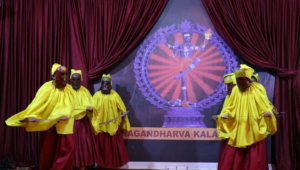 Based on the rules of Kaula Siddha Dharma laid down by the great Gurumandala, it is always compulsory to present Bhairava/Bhairavi nritya infront of Kaulantak Nath whenever he is seated on the rajasic Siddha throne. It is a compulsory rule but based on personal discretion, Kaulantak Nath can waive this obligation based on his own discretion and understanding of the situations.
Based on the rules of Kaula Siddha Dharma laid down by the great Gurumandala, it is always compulsory to present Bhairava/Bhairavi nritya infront of Kaulantak Nath whenever he is seated on the rajasic Siddha throne. It is a compulsory rule but based on personal discretion, Kaulantak Nath can waive this obligation based on his own discretion and understanding of the situations.
The Bhairava/Bhairavi nritya is the dance of Bhairava and Bhairavis performed in front of Kaulantak Nath. Normally, Bhairava Nritya is more compulsory then the Bhairavi nritya.
Bhairava nritya is the group dance of the Bhairavas done with the purpose of subjugating enemies of Dharma. The main aim of Bhairava nritya is to always inspire Bhairavas to be warrior like and then protect the Dharma. Therefore, the Bhairava nritya is done with Bhairava mask and a sword. The Bhairava expresses various mudra suggesting the triumph of Bhairava winning the battle against the adharma. He is also portrayed in the dance with the mudra of riding a horse and then an ecstatic dance. All in all, Bhairava nritya is the dance of revival of Dharma.
The Bhairavi dance is performed with similar motive but since Bhairavi being the manifestation of the supreme Shakti, their dance is based on Laasa nritya. Laasa nritya is all about creation, creativity, aesthetic virtues and rajas. Therefore, the Bhairavi dance is performed with the sole aim of inspiring the Bhairavas and Kaulantak Nath to maintain the beauty and aesthetic values by defeating the dark forces.
Occasional dance of Mriga Nritya (deer dance)
Most of the times, the Kaulantak Nath is presented by Bhairava/Bhairavi nrityas. But there are some special times where occasionally “Mriga Nritya” or deer dance is performed. It is performed by two individuals who dress up as a deer and then the simple dance is performed.
The main theme of the deer dance is the animal deer. Deer is symbolic representation of chanchalata/fidgetiness and Maya. It also denotes “Mrigatrishana” or mirage. A deer is a very fidget animal. It is frequently in motion and it is seldom laid back. Due to it’s over fidgetiness, it gets the illusion of mirage and chases the water never to find it and ultimately dies.
It is a very symbolic dance. The mirage of the deer’s is symbolic representation of our inner desires and we are the deer. Just like the deer is born in the jungle, grazes in the jungle and ultimately dies chasing in the jungle, we humans are no different. It is the desire that rules us. It is the craving of desires that makes a human fidget like the deer. Little does the human know that the system is Maya, exactly like the mirage. Neither does our craving finish nor the Maya.
The dance is therefore presented in front of Kaulantak Nath as a symbolic representation of Maya and our interaction with Maya. We should interact with Maya in such a way that despite all our fidgetiness, we could still fulfill all our wishes and then through the knowledge bestowed to us by Kaulantak Nath free ourselves from Maya.
Purpose of all the dikshas and sadhanas granted by Kaulantak Nath
 The Kaulantak Peeth in its inception was formed by Lord Shiva to impart his wisdoms forward to the future Siddhas and they in return had to impart it to the society. Kaulantak Peeth is basically a big spiritual university which had its own land that enclosed the mountain ranges spread from Russia to Afghanistan, Pakistan, Nepal, Bhutan extended till Burma. The subject taught were the subjects propounded by Lord Shiva.
The Kaulantak Peeth in its inception was formed by Lord Shiva to impart his wisdoms forward to the future Siddhas and they in return had to impart it to the society. Kaulantak Peeth is basically a big spiritual university which had its own land that enclosed the mountain ranges spread from Russia to Afghanistan, Pakistan, Nepal, Bhutan extended till Burma. The subject taught were the subjects propounded by Lord Shiva.
Because the Peeth was formed with the intention of spreading the wisdoms of Lord Shiva to the future Siddhas, the main aim of the Peeth has always been to impart and empower the Siddhas with dikshas and sadhanas. The dikshas and sadhanas that are given are not prejudiced to any particular Kula. Different dikshas and sadhanas ranging from satwik to tamas, dakshina marga to vaama marga, yoga to kaula marga, tantra to bhakti marga are imparted with the sole intention of imparting pure wisdoms and knowledges. The Peeth doesn’t guarantee any enlightment, mokshas etc but the path to them.
The authentic text of the Kaula Siddha Dharma i.e the Agama and Nigama is filled with the conversation between Lord Shiva and Ma Parvati. In one of the text, Ma Parvati enquires Lord Shiva on what Samadhi is? The Lord of all lords does not give her the explanation of the state of Samadhi but he dwells directly to the technique of reaching the state of Samadhi and shows her the way. Even Lord Shiva did not guarantee the state of Samadhi to Ma Parvati because it all depended on her hard work and sadhana. The Lord in short, gave a nut to her, but it was the duty of Ma Parvati to crack it herself. The Lord can only teach her the technique of cracking the nut but it all boils down to how Ma Parvati cracks it.
Similarly, it is the Kaulantak Nath who in his Shiva form, mandatorily has to impart dikshas to the Siddhas. Like Lord Shiva, he only gives us the nut to eat but he leaves it upon the Bhairavas and Bhairavis to crack it themselves. He does teach the techniques of cracking the nut but it ultimately boils down to the Bhairava and Bhairavis on how they crack it.
Lastly, the dikshas and sadhanas that is imparted to the Siddhas have no connection with miracles. The Kaulantak Nath while imparting dikshas does not promote miracles and supernatural claims like others do. The Kaula Siddha Dharma only promotes education, oriental wisdoms of the Rishi/Muni and in doing so, Kaulantak Nath never sells fantasy to the people. It is his duty to present the timeless wisdoms as it as, and not based on how and what the public wants to hear.
Kaulantak Nath and the Kaula Siddha Team
The Kaulantak Nath is the king among the Kaula Siddhas. He was made the head of the Kaula Siddha lineage by the great Gurumandala. The great Gurumandala has also laid down some facilities for the Kaulantak Nath. One of the foremost facilities given to the Kaulantak Nath is a team of Siddhas who manages his daily affairs. Since, Kaulantak Nath main duties is to impart oriental wisdoms of the Lord Shiva and the Gurumandala to the society, it would be a great loss of time if he himself does all his works. If the great Kaulantak Nath becomes busy in small affairs then he wouldn’t have time to focus on his purpose. Therefore, for his convenance the Gurumandala has prescribed and facilitated a Kaula Siddha Team for handling his day to day works and also helping to spread the wisdoms of the Gurumandala.
The Kaula Siddha team is a team composed of more than two Bhairavas and Bhairavis. There is no fixation of their service period. The Bhairava and Bhairavis render there services to the team in circular fashion. They voluntarily come and serve and voluntarily leave and then again in some future point render their service voluntarily.
Like Kaulantak Nath is bounded by the rules of the Gurumandala, the Kaula Siddha Team is no different. They are also bounded by the rules of Gurumandala. Following are the rules prescribed by the Gurumandala to the Kaula Siddha Team.
Security of Kaulantak Nath
It is the prime duty of the ‘Kaula Siddha Team’ to provide security to Kaulantak Nath. In today’s modern day and age, no associations of people are ever free from infiltrators. Not all people who visit Kaulantak Nath, come to him with good faith. Different people have different purposes to visit Kaulantak Nath. The Kaulantak Peeth tradition has faced many infiltrators in the past. The Kaula Siddha Team main job is to provide security to Kaulantak Nath against those infiltrators. They do so by spotting them and then peacefully ousting them from the Peeth. The team also provides securities to Kaulantak Nath in the public spheres like meeting, outing etc.
Provide Public comfort
One of the main duties of Kaulantak Nath Sewa Mandala is also to provide public comfort to Kaulantak Nath. It is virtually impossible for him to meet every person for his daily life activities. He is most of the time in seclusion because the rules of Kaulantak Peeth do not permit him to be easily available to everybody. He is only advised to meet individuals who have spiritual affinities and with the purpose of promoting the Kaula Siddha lineage. Furthermore, it is also the Kaulantak Nath Sewa Mandala who manages the food, attire, residence and various other aspects of Kaulantak Nath.
For instance, it is the team who looks after his attire. But someday as mentioned before, if Kaulantak Nath has to go somewhere that does not promote the Kaula Siddha lineage and the teachings of Gurumandala like Police station, courts etc, it is the Kaulantak Nath Sewa Mandala that manages the suitable dress for him other then the loin cloth. It is not prescribed cloth but in that particular situation, any other cloths besides the loin cloths are to be best worn and it is provided to Kaulantak Nath by the team.
Maintain respect of the Kaulantak Nath and the tradition
It is the utmost duty of the ‘Kaulantak Nath Sewa Mandala’ to ensure that the respect of the Kaulantak Nath and the Kaula Siddha Dharma is always maintained. Respect is a virtue which people try to derogate to their level so as to temper it. The ‘Kaulantak Nath Sewa Mandala’ tries its best to always maintain the respect of the tradition and Kaulantak Nath by ensuring the standards below.
- The dress code of the Kaula Siddha Dharma is always followed bar some situations and conditions.
- Various rules and regulations are introduced for the Bhairava and Bhairavis for their code of conduct in front of Kaulantak Nath.
Perform “Kaulantak Nath Astottarsatnamawali” daily so as to always be in the subtle proximity of Kaulantak Naths.
- The Kaulachara salutation to be performed as much as possible for the Bhairava and Bhairavis in front of Kaulantak Nath
- Freeing the Kaula Siddha Dharma from narcotics and unsocial practices.
- To organize monthly sadhana camps and occasionally a week course for Kaulantak Nath to promote his traditions.
- To protect the people against any cheating, misconduct done in the name of Kaulantak Nath and the Kaula Siddha Dharma. etc

